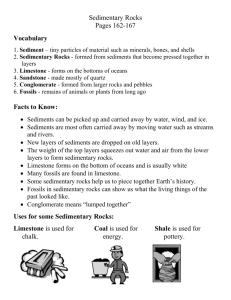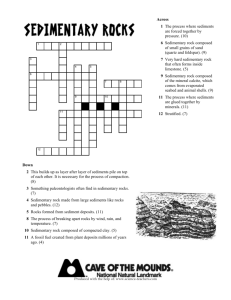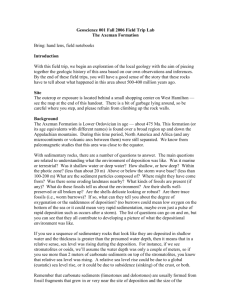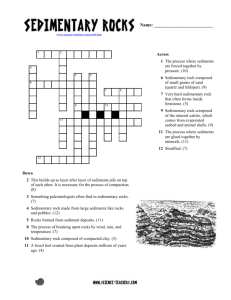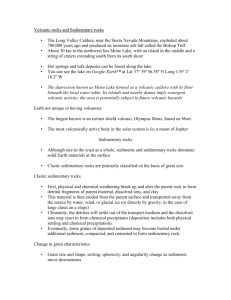File
advertisement
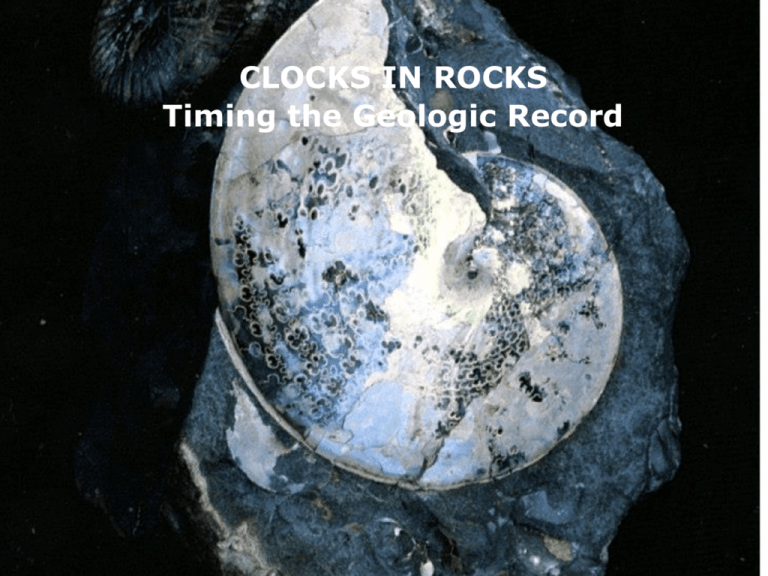
CLOCKS IN ROCKS Timing the Geologic Record The Stratigraphic Record Important Principles 1. Original horizontality—sediments were deposited originally as horizontal beds. 2. Lateral continuity—beds thin and pinch out laterally. 3. Superposition—overlying beds are younger than underlying beds in a succession of sedimentary strata that are undisturbed by tectonic forces. 4. Cross cutting relationships—a feature that disrupts a previously formed feature is younger than the one that is disrupted. For example, the folding event post-dates the deposition of the sediment, or the dyke is younger than the rocks it cross-cuts. Geologic time • geology’s greatest contribution to science (deep time). • emphasizes that geology is a historical science. Rocks record evolution of the earth system and its biotic inhabitants. • earth scientists use observation, and the principles and tools of physics, chemistry, mathematics and biology to piece together the story from the clues left behind in rocks. Relative Dating • relies on principles of original horizontality, superposition and cross cutting relationships • can only determine that some event is older or younger than another • cannot determine the duration of an event. Sedimentation in lake or sea Sedimentation in lake or sea Sediments are deposited in horizontal layers and slowly change into rock. Principle of original horizontality Younger Older If left undisturbed, the youngest layers remain above the oldest. Correlation of Sedimentary Rocks Question Can we correlate by establishing the physical continuity of the sedimentary rock record; i.e., walking out bed contacts between one area and another? Answer Difficult to do in practice because we can’t correlate across oceans, continents, or even across highways in some instances due to: (1) tectonic disruption of the beds (2) non-deposition, and (3) erosion. Lithostratigraphy— correlation of sedimentary rock units through a comparison of the stratigraphic succession of rock types, bed thicknesses, and structures. Very unreliable. Missing strata not accounted for (unconformities). Also changes in bed thicknesses and sedimentary facies changes. Sedimentary facies are the rock attributes that reflect the characteristics of the depositional environment (e.g., near shore sands, offshore muds) offshore Facies change in bed thickness nearshore Shoreward pinchout of limestone facies, basinward pinchout of sand facies. Unconformities— missing (time) in a stratigraphic succession of sedimentary rocks. Nonconformity–sedimentary rocks overlying igneous or metamorphic rocks Disconformity–missing time in a conformable succession of sedimentary rocks. Often only detectable using principle of faunal succession. Angular unconformity–sedimentary rocks overlying igneous or metamorphic rocks Unconformities are a major source of error in lithostratigrphic correlation. Biostratigraphy— correlation of sedimentary rock units through a comparison of their fossil types and the pattern of their succession. Very reliable. Biostratigraphic correlation is based on the principle of faunal succession, which states that fossils succeed one another in a definite and recognizable order (biotic evolution). The fossil record is a record of faunal succession. Fossils have limited stratigraphic (time) range within the sedimentary rock record. Index fossils and biostratigraphy •The shorter the time-stratigraphic range of the fossil, the more precise are the correlations that can be made. •Fossils representing free swimming or drifting organisms can be found world wide and deposited in a wide variety of rock type (different depositional environments). These are the most useful for global correlation of the stratigraphic record. They are called index fossils. Conodonts Graptolites Conodonts Graptolites Trilobites Brachiopods An application of biostratigraphy Outcrop A I Outcrop B II II III An application of biostratigraphy Some of the fossils found in outcrop A are the same as fossils found in outcrop B, some distance away. (Law of Faunal Succession) Outcrop A Outcrop B I II II Layers with the same fossils are the same age. III A example of stratigraphic correlation D C B A TIME 1 Beneath the sea, sediments accumulated in beds. D C B A TIME 2 Tectonic forces caused uplift, exposing the beds to erosion. Uplift C B A TIME 3 Erosion stripped away bed D and part of C. E C B A TIME 4 Subsidence allowed a new layer, E, to be deposited. Subsidence Unconformity TIME 1 Beneath the sea, sediments accumulated in beds. Compression TIME 2 Tectonic forces caused uplift, folding, and deformation. Uplift TIME 3 Erosion stripped away the tops of the folded layers, leaving portions of several layers exposed. Angular unconformity TIME 4 Subsidence allowed new sediments to be deposited. Subsidence TIME 1 Beneath the sea, sediments accumulated in beds. TIME 2 Tectonic forces caused uplift, folding, and deformation. Dike TIME 3 A dike from molten magma intruded the folded layers. Pluton TIME 4 Faulting displaced the layers and the intruding dike. Fault Sandstones containing land fossils E C B A F D Angular unconformity E Sandstones, limestones, and shales containing marine fossils Unconformity C Granite pluton intrusion Deformed metamorphosed sedimentary rocks Walther’s Law Sediments from depositional environments occurring beside each other at the present day will be found on top on each other in the stratigraphic record due to sea level changes. Laterally distributed environments of deposition Transgression denotes sea level rise Vertical arrangement of sedimentary facies Walther’s Law Sediments from depositional environments occurring beside each other at the present day will be found on top on each other in the stratigraphic record due to sea level changes. Laterally distributed environments of deposition Regression denotes sea level fall Vertical arrangement of sedimentary facies Transgression/Regression Click here to view the Flash animation in your web browser Seismic technology can be used to create seismic profiles,… …which allow geologists to see individual beds in a sequence. Seismic sequence Younger strata Seismic profile Younger strata Sequence C Sequence C Sequence B Sequence A Sequence B Sequence A Older strata Older strata The seismic sequence reveals changes in sedimentation. C Delta B A A sequence of delta sediments, B, accumulates over previous sediments, A. B Sediment The sea level rises, and the shoreline recedes inland. A Another sedimentary sequence, C, accumulates over sequence B. The relative geologic timescale …what came before…what came after…exquisitely pieced together Dating transforms the relative timescale into an absolute one. It allows us to know the duration of events. Clocks in rocks: absolute dating Clocks in rocks: absolute dating Rubidium-87 nucleus Neutrons Protons Electron Rubidium-87 nucleus Neutrons Protons Electron A neutron decays, ejecting an electron… Rubidium-87 nucleus Neutrons Strontium-87 nucleus Protons Electron A neutron decays, ejecting an electron… Absolute Dating Rubidium-87 nucleus Neutrons Strontium-87 nucleus Protons Electron A neutron decays, ejecting an electron… …and producing a proton, which changes the atom. Radiometric Dating D* = number of daughter isotopes produced from decay of parent N



